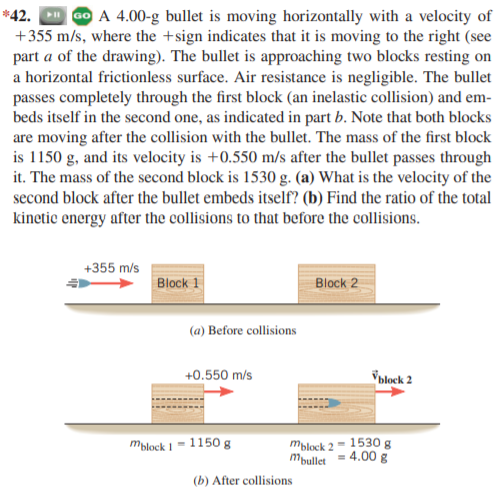GO A 4.00-g bullet is moving horizontally with a velocity of +355 m/s, where the +sign indicates that it is moving to the right (see part a of the drawing). The bullet is approaching two blocks resting on a horizontal frictionless surface. Air resistance is negligible. The bullet passes completely through the first block (an inelastic collision) and em- beds itself in the second one, as indicated in part b. Note that both blocks are moving after the collision with the bullet. The mass of the first block is 1150 g, and its velocity is +0.550 m/s after the bullet passes through it. The mass of the second block is 1530 g. (a) What is the velocity of the second block after the bullet embeds itself? (b) Find the ratio of the total kinetic energy after the collisions to that before the collisions. *42. +355 m/s Block 1 Block 2 (a) Before collisions +0.550 m/s Vblock 2 1530 g 4.00 g mblock I = 1150 g mblock 2 mbullet (b) After collisions
GO A 4.00-g bullet is moving horizontally with a velocity of +355 m/s, where the +sign indicates that it is moving to the right (see part a of the drawing). The bullet is approaching two blocks resting on a horizontal frictionless surface. Air resistance is negligible. The bullet passes completely through the first block (an inelastic collision) and em- beds itself in the second one, as indicated in part b. Note that both blocks are moving after the collision with the bullet. The mass of the first block is 1150 g, and its velocity is +0.550 m/s after the bullet passes through it. The mass of the second block is 1530 g. (a) What is the velocity of the second block after the bullet embeds itself? (b) Find the ratio of the total kinetic energy after the collisions to that before the collisions. *42. +355 m/s Block 1 Block 2 (a) Before collisions +0.550 m/s Vblock 2 1530 g 4.00 g mblock I = 1150 g mblock 2 mbullet (b) After collisions
Physics for Scientists and Engineers: Foundations and Connections
1st Edition
ISBN:9781133939146
Author:Katz, Debora M.
Publisher:Katz, Debora M.
Chapter11: Collisions
Section: Chapter Questions
Problem 64PQ: From what might be a possible scene in the comic book The X-Men, the Juggernaut (mJ) is charging...
Related questions
Question

Transcribed Image Text:GO A 4.00-g bullet is moving horizontally with a velocity of
+355 m/s, where the +sign indicates that it is moving to the right (see
part a of the drawing). The bullet is approaching two blocks resting on
a horizontal frictionless surface. Air resistance is negligible. The bullet
passes completely through the first block (an inelastic collision) and em-
beds itself in the second one, as indicated in part b. Note that both blocks
are moving after the collision with the bullet. The mass of the first block
is 1150 g, and its velocity is +0.550 m/s after the bullet passes through
it. The mass of the second block is 1530 g. (a) What is the velocity of the
second block after the bullet embeds itself? (b) Find the ratio of the total
kinetic energy after the collisions to that before the collisions.
*42.
+355 m/s
Block 1
Block 2
(a) Before collisions
+0.550 m/s
Vblock 2
1530 g
4.00 g
mblock I
= 1150 g
mblock 2
mbullet
(b) After collisions
Expert Solution
This question has been solved!
Explore an expertly crafted, step-by-step solution for a thorough understanding of key concepts.
This is a popular solution!
Trending now
This is a popular solution!
Step by step
Solved in 2 steps with 2 images

Recommended textbooks for you

Physics for Scientists and Engineers: Foundations…
Physics
ISBN:
9781133939146
Author:
Katz, Debora M.
Publisher:
Cengage Learning

Classical Dynamics of Particles and Systems
Physics
ISBN:
9780534408961
Author:
Stephen T. Thornton, Jerry B. Marion
Publisher:
Cengage Learning

Physics for Scientists and Engineers: Foundations…
Physics
ISBN:
9781133939146
Author:
Katz, Debora M.
Publisher:
Cengage Learning

Classical Dynamics of Particles and Systems
Physics
ISBN:
9780534408961
Author:
Stephen T. Thornton, Jerry B. Marion
Publisher:
Cengage Learning